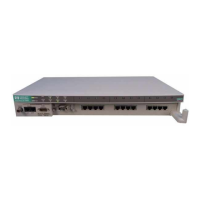431
To configure a totally NSSA area, configure the nssa no-summary command on the ABR. The ABR
of a totally NSSA area does not advertise inter-area routes into the area.
To configure an NSSA area:
1. Enter system view.
system-view
N/A
2. Enter OSPFv3 view.
ospfv3
[ process-id |
vpn-instance
vpn-instance-name ] *
N/A
3. Enter OSPFv3 area view.
area
area-id
N/A
4. Configure the area as an
NSSA area.
nssa
[
default-route-advertise
[
cost
cost-value |
nssa-only
|
route-policy
route-policy-name |
tag
tag |
type
type ] * |
no-import-route
|
no-summary
|
[
translate-always
|
translate-never
] |
suppress-fa
|
translator-stability-interval
value ] *
By default, no area is configured as
an NSSA area.
5. (Optional.) Set a cost for
the default route advertised
to the NSSA area.
default-cost
cost-value
The default setting is 1.
This command takes effect only on
the ABR/ASBR of an NSSA or
totally NSSA area.
Configuring an OSPFv3 virtual link
You can configure a virtual link to maintain connectivity between a non-backbone area and the
backbone, or in the backbone itself.
Both ends of a virtual link are ABRs that must be configured with the vlink-peer command.
• Do not configure virtual links in the areas of a GR-capable process.
To configure a virtual link:
1. Enter system view.
system-view
N/A
2. Enter OSPFv3 view.
ospfv3
[ process-id |
vpn-instance
vpn-instance-name ] *
N/A
3. Enter OSPFv3 area view.
area
area-id
N/A
4. Configure a virtual link.
vlink-peer
router-id [
dead
seconds |
hello
seconds |
instance
instance-id |
keychain
keychain-name |
retransmit
seconds |
trans-delay
seconds ] *
By default, no virtual links
exist.
Configuring OSPFv3 network types
By the link layer protocol, OSPFv3 classifies networks into different types, including broadcast,
NBMA, P2MP, and P2P. By default, OSPFv3 considers the network type as broadcast.

